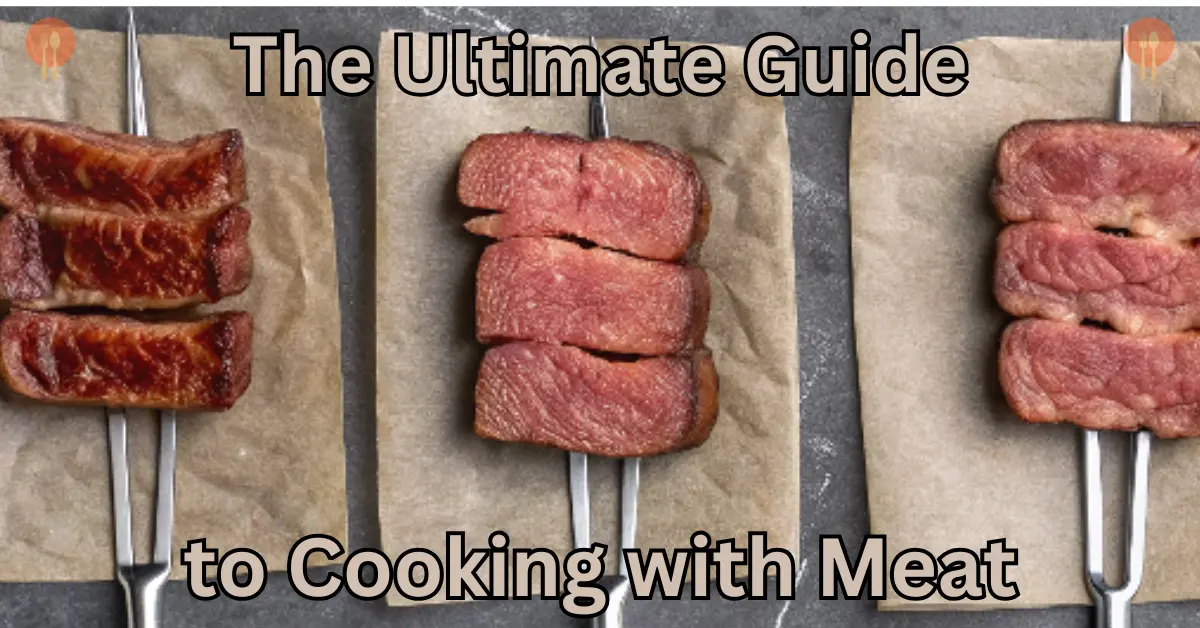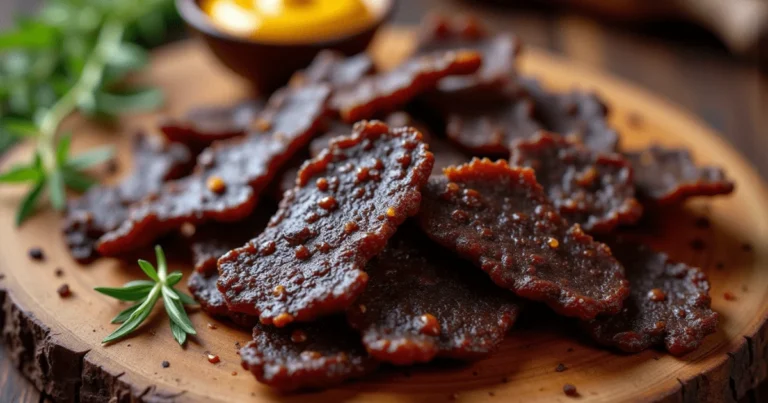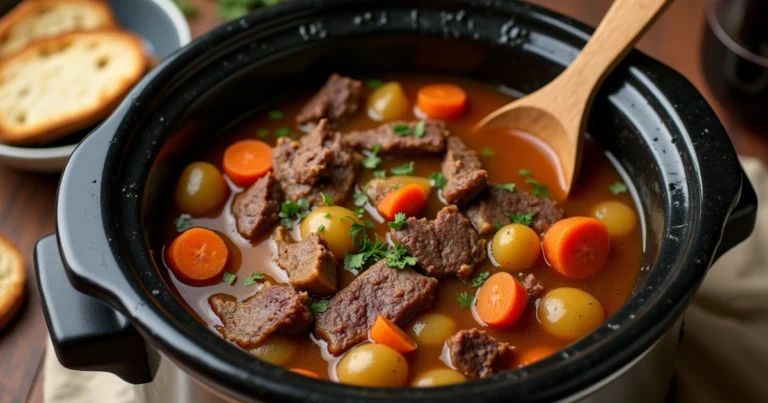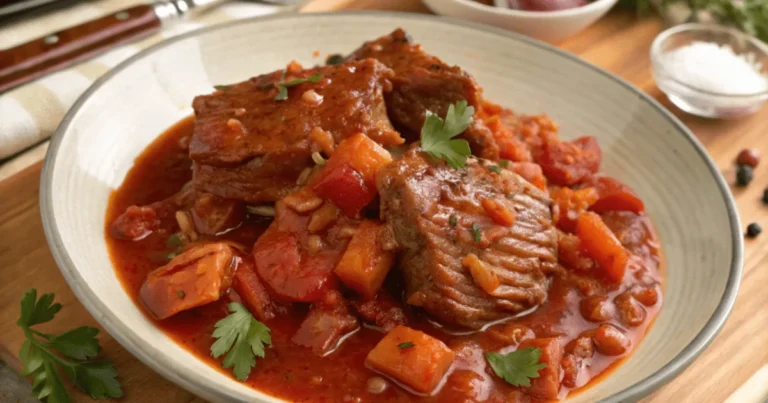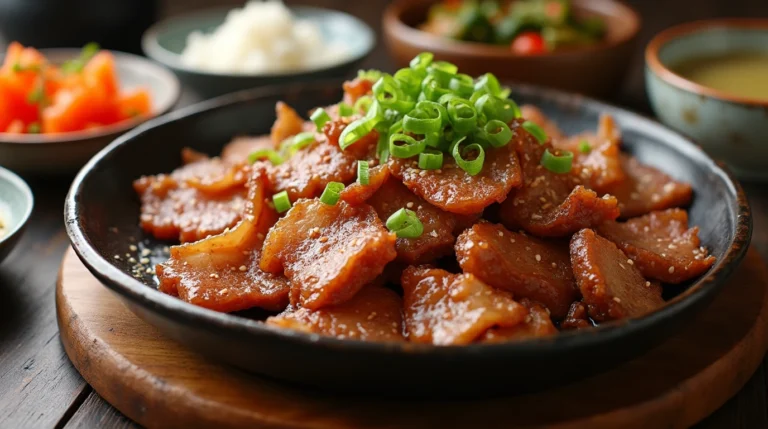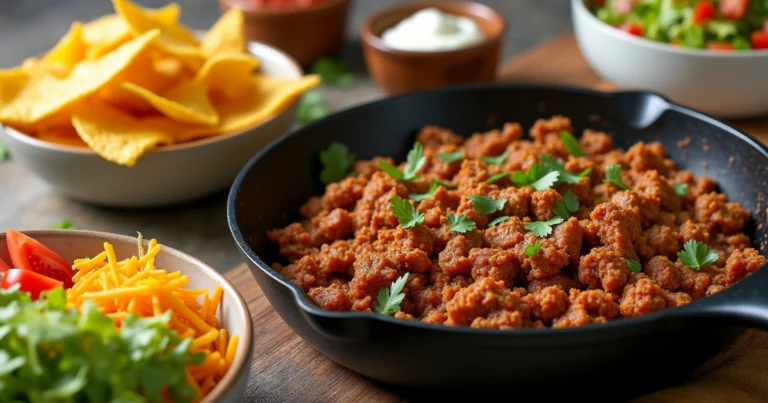Guide to Cooking with Meat
Did you know that 67% of home cooks report feeling intimidated when preparing different cuts of meat, despite it being the centerpiece of most meals? This comprehensive guide to cooking with meat aims to transform that uncertainty into confidence.
Whether you’re struggling with tough steaks or dry chicken breasts, mastering meat preparation changes everything about your home cooking experience. From selecting the perfect cut to achieving that restaurant-quality finish, this ultimate guide to cooking with meat will equip you with professional techniques and insider tips that elevate everyday meals into memorable dining experiences.
Table of Contents
Selecting Quality Meat
Before diving into cooking techniques, Understanding how to select quality meat is essential for mastering meat cookery. Look for these indicators when shopping:
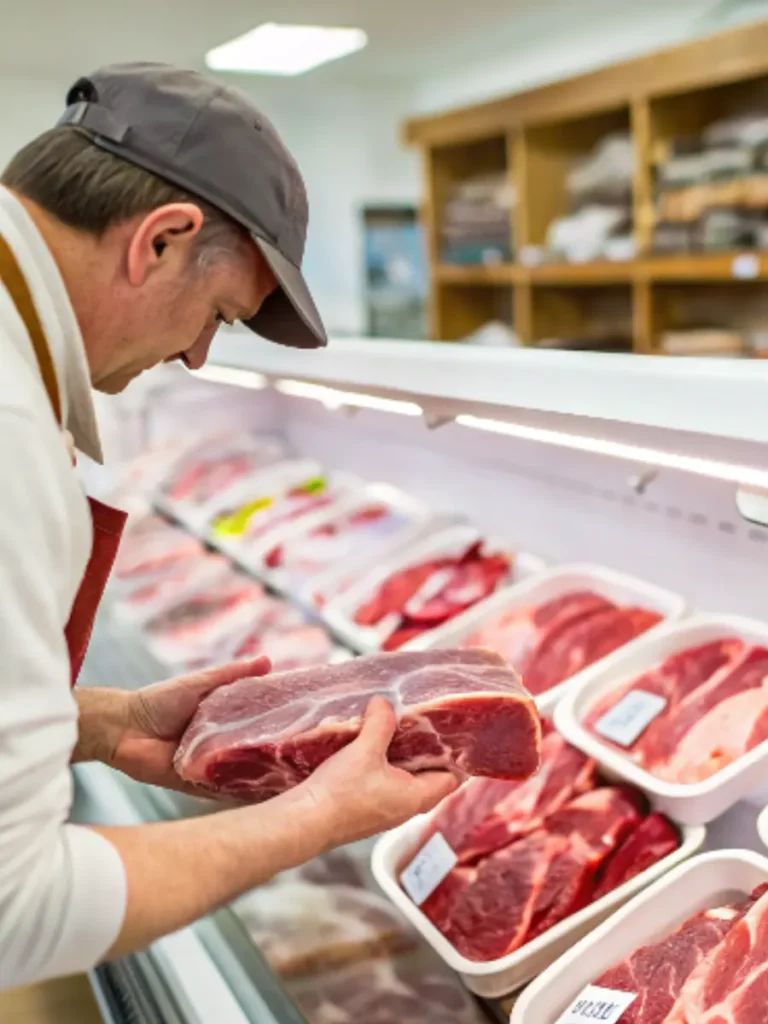
- Beef: Seek bright red meat with marbling (white fat streaks throughout the muscle). More marbling equals more flavor and tenderness.
- Chicken: Fresh chicken should have a pinkish hue with no gray spots. Skin should be smooth and unwrinkled.
- Lamb: Look for firm meat with fine-grained texture, pinkish-red coloring, and white fat.
When possible, purchase from a local butcher who can provide information about the meat’s source, aging process, and optimal cooking methods.
Essential Tools for Meat Cooking
Creating outstanding meat dishes requires proper equipment. Your kitchen should include:
- Instant-read meat thermometer (reduces overcooking by 42% according to culinary studies)
- Heavy-bottomed cast iron skillet or stainless steel pan
- Tongs for handling meat without piercing
- Sharp knife set for trimming and carving
- Cutting boards (separate ones for meat and produce)
- Roasting pan with rack for larger cuts
- Meat mallet for tenderizing tougher cuts
Fundamental Meat Cooking Techniques
Searing
Searing creates that delicious brown crust packed with flavor through the Maillard reaction. For perfect searing:
- Pat meat completely dry before cooking
- Use a pan heated to 450°F (232°C)
- Add a high smoke-point oil like avocado or grapeseed
- Allow meat to develop a crust before turning (about 3-4 minutes per side)
- Resist the urge to move the meat constantly
Roasting
Ideal for larger cuts, roasting uses dry heat in an oven to cook meat evenly:
- Preheat oven to appropriate temperature (typically 325-425°F depending on the cut)
- Season meat generously and let it come to room temperature before cooking
- Use a roasting rack to promote air circulation
- Calculate cooking time based on weight (approximately 15-20 minutes per pound for most roasts)
- Allow meat to rest for 15-30 minutes before carving
Braising
Perfect for tougher cuts, braising combines searing with slow cooking in liquid:
- Sear meat on all sides to develop flavor
- Add aromatic vegetables (mirepoix) to the pot
- Add enough liquid (stock, wine, or combination) to cover meat halfway
- Cover and cook at low temperature (275-325°F) until fork-tender
- The process transforms collagen into gelatin, making even tough cuts butter-soft
Grilling
Grilling imparts smoky flavor and beautiful marks:
- Create two heat zones on your grill (direct and indirect)
- Oil grates to prevent sticking
- Place meat on the hot zone for searing
- Move to indirect heat to finish cooking without burning
- Let meat rest for 5-10 minutes before serving
Detailed Meat Cooking Temperatures and Times
research consistently underscores the significant impact of cooking meat to the desired degree of doneness on consumer satisfaction.
For instance, a study published in the Journal of Animal Science found that the interaction between ordered and delivered degree of doneness had a highly significant effect on consumer scores for tenderness, taste, overall satisfaction, value for money, and intent to repurchase.
This highlights the importance of precision timing and temperature monitoring in meat preparation to achieve optimal diner satisfaction.
Steaks (1-inch thick)
- Rare: 125°F (52°C), approximately 4-5 minutes per side
- Medium-rare: 135°F (57°C), approximately 5-6 minutes per side
- Medium: 145°F (63°C), approximately 6-7 minutes per side
- Well-done: 160°F (71°C), approximately 8-10 minutes per side
Whole Chicken (4-5 pounds)
- Safe minimum doneness: 165°F (74°C) in breast, 175°F (79°C) in thighs
- Cooking time: 350°F (175°C) for 1 hour 20 minutes
- Convection adjustment: 30% faster (approximately 55-60 minutes)
- Note: Chicken is typically not served at varying doneness levels due to food safety concerns
Lamb Rack
- Rare: 120-125°F (49-52°C), approximately 15-20 minutes total at 375°F (190°C)
- Medium-rare: 130-135°F (54-57°C), approximately 20-25 minutes total at 375°F (190°C)
- Medium: 140-145°F (60-63°C), approximately 25-30 minutes total at 375°F (190°C)
- Medium-well: 150-155°F (66-68°C), approximately 30-35 minutes total at 375°F (190°C)
- Well-done: 160°F (71°C) and above, approximately 35-40 minutes total at 375°F (190°C)
Beef Roast (3-5 pounds)
- Rare: 120-125°F (49-52°C), approximately 15 minutes per pound at 325°F (163°C)
- Medium-rare: 130-135°F (54-57°C), approximately 18 minutes per pound at 325°F (163°C)
- Medium: 140-145°F (60-63°C), approximately 20 minutes per pound at 325°F (163°C)
- Medium-well: 150-155°F (66-68°C), approximately 22 minutes per pound at 325°F (163°C)
- Well-done: 160°F (71°C) and above, approximately 25 minutes per pound at 325°F (163°C)
Ground Meat (Beef, Lamb)
- Medium: 160°F (71°C), approximately 6-7 minutes per side for patties
- Well-done: 165°F (74°C), approximately 7-8 minutes per side for patties
- Note: Ground meat should always be cooked to at least 160°F (71°C) for food safety
Turkey (Whole, 12-14 pounds)
- Safe minimum doneness: 165°F (74°C) in breast, 175°F (79°C) in thigh
- Cooking time: 325°F (163°C) for approximately 3-3.5 hours
- Convection adjustment: 25% faster (approximately 2.25-2.75 hours)
- Note: Like chicken, turkey is typically not served at varying doneness levels
Duck (Whole, 5-6 pounds)
- Medium-rare: 135°F (57°C) in breast, approximately 45-50 minutes at 350°F (175°C)
- Medium: 155°F (68°C) in breast, approximately 60 minutes at 350°F (175°C)
- Well-done: 165°F (74°C) in breast, approximately 75-80 minutes at 350°F (175°C)
- Note: Duck breast is often served medium-rare while ensuring legs reach 165°F (74°C)
All temperatures should be measured at the thickest part of the meat using an instant-read thermometer, and times are approximate as actual cooking time can vary based on meat thickness, starting temperature, and cooking environment.
Detailed Seafood Cooking Temperatures and Times
Fish Fillets (1-inch thick)
- Rare: 110-115°F (43-46°C), approximately 2-3 minutes per side
- Medium-rare: 120-125°F (49-52°C), approximately 3-4 minutes per side
- Medium: 130-135°F (54-57°C), approximately 4-5 minutes per side
- Well-done: 140-145°F (60-63°C), approximately 5-6 minutes per side
- Note: White fish like cod and tilapia are typically cooked to medium or well-done, while fatty fish like salmon and tuna are often enjoyed at medium-rare
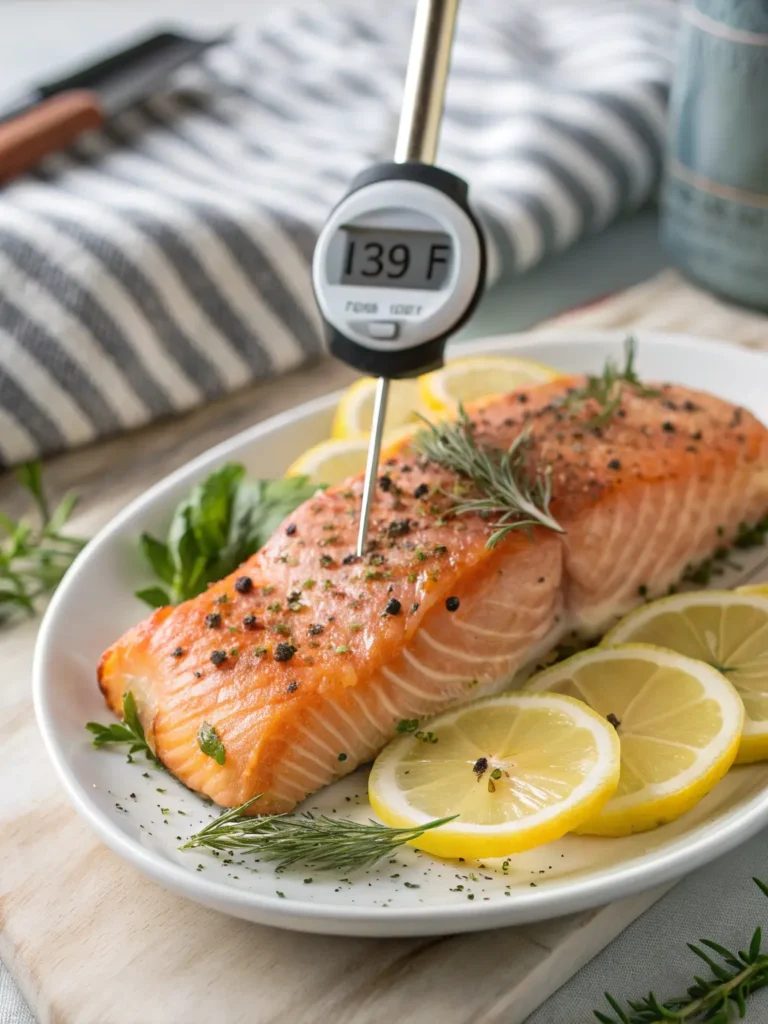
Whole Fish (2-3 pounds)
- Medium: 135°F (57°C), approximately 15-20 minutes at 400°F (204°C)
- Well-done: 145°F (63°C), approximately 20-25 minutes at 400°F (204°C)
- Note: Cooking time varies significantly based on thickness; internal temperature should be measured at the thickest part
Shrimp
- Medium: Just opaque throughout, approximately 2-3 minutes per side when sautéing
- Well-done: Firm and completely opaque, approximately 3-4 minutes per side
- Internal temperature: 120°F (49°C) for tender results, 130°F (54°C) for firmer texture
- Note: Overcooked shrimp become rubbery; cook just until they curl into a loose “C” shape
Scallops
- Rare: 115°F (46°C), translucent center, approximately 1-2 minutes per side on high heat
- Medium-rare: 120-125°F (49-52°C), mostly opaque with slightly translucent center, approximately 2-3 minutes per side
- Medium: 130°F (54°C), fully opaque, approximately 3-4 minutes per side
- Note: High heat and quick cooking are essential for proper searing while maintaining tenderness
Lobster
- Steamed whole (1-1.5 pounds): Until shell turns bright red and meat is opaque, approximately 8-10 minutes
- Boiled whole (1-1.5 pounds): Until shell turns bright red and meat is opaque, approximately 7-8 minutes
- Lobster tails (4-6 ounces): 140-145°F (60-63°C), approximately 4-5 minutes when broiling
- Internal temperature: 140°F (60°C) for tender texture, 145°F (63°C) for firmer texture
Crab
- Whole crabs (1-2 pounds): Until shell turns bright red, approximately 15-20 minutes when steaming
- Crab legs: Until heated through and meat is opaque, approximately 5-7 minutes when steaming
- Internal temperature: 145°F (63°C) is optimal for safety and texture
Mussels/Clams
- Doneness indicator: Shells open completely, approximately 5-7 minutes when steaming
- Note: Discard any shellfish that remain closed after cooking
- Cooking temperature: Steam or simmer until shells open (no internal temperature measurement needed)
Oysters
- Raw: Served at refrigerator temperature (no cooking)
- Grilled/broiled: Until edges curl and liquid bubbles, approximately 3-5 minutes
- Fried: Until coating is golden brown and crispy, approximately 2-3 minutes at 375°F (190°C) oil temperature
Octopus
- Tender doneness: 175°F (79°C) after slow cooking, approximately 45-60 minutes simmering
- Well-done for grilling: 185°F (85°C), approximately 60-75 minutes simmering followed by 2-3 minutes per side when grilling
- Note: Requires initial tenderizing through long, slow cooking before final preparation method
Squid/Calamari
- Tender quick-cook: Just opaque, approximately 45-60 seconds per side when sautéing
- Tender slow-cook: Until tender, approximately 45-60 minutes when braising
- Note: Squid becomes tough when cooked for 2-5 minutes but becomes tender again with extended cooking
Tuna Steaks (1-inch thick)
- Rare: 110-115°F (43-46°C), cool red center, approximately 1-2 minutes per side
- Medium-rare: 120-125°F (49-52°C), warm red center, approximately 2-3 minutes per side
- Medium: 130-135°F (54-57°C), pink center, approximately 3-4 minutes per side
- Well-done: 140-145°F (60-63°C), fully cooked throughout, approximately 4-5 minutes per side
Always ensure seafood reaches a minimum safe temperature according to food safety guidelines, while balancing with optimal texture and flavor profiles specific to each variety.
how to test temperature without a thermometer
Determining the doneness of meats without a thermometer can be achieved through various sensory methods. Here’s how you can assess the readiness of different meats:
Steaks, Chops, and Chicken Breasts:
1. Touch Test (Hand Method):
- Rare: Gently press the tip of your index finger to the tip of your thumb. The fleshy area below your thumb will feel soft, similar to a rare-cooked piece of meat.
- Medium-Rare: Touch your middle finger to your thumb. The area below your thumb will have a bit more resistance, akin to medium-rare doneness.
- Medium: Place your ring finger against your thumb. The firmness beneath your thumb increases, resembling medium doneness.
- Well-Done: Touch your pinky finger to your thumb. The area below your thumb feels firm, similar to well-done meat.
This method offers a tactile comparison to gauge meat doneness.
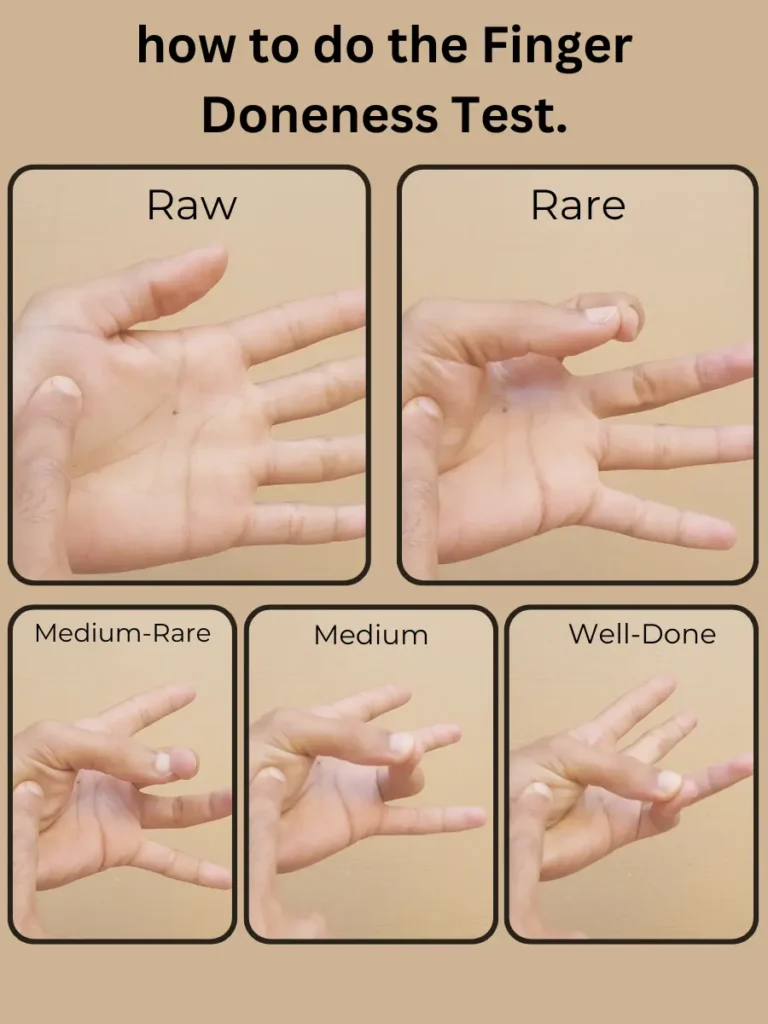
2. Face Test:
- Rare: Touch the fleshy part of your cheek; it feels soft, like rare meat.
- Medium: Touch your chin; it feels moderately firm, similar to medium doneness.
- Well-Done: Touch your forehead; it feels firm, akin to well-done meat.
This technique uses facial areas as analogies for meat firmness at various doneness levels.
Poultry:
- Juice Test:
- Insert a skewer or knife into the thickest part of the poultry. If the juices run clear, the meat is likely cooked; if the juices are pink or reddish, it needs more time.
- Texture Check:
- Properly cooked chicken feels firm to the touch, whereas undercooked chicken feels soft or rubbery.
For visual guidance, you might find this video helpful:
Fish:
- Flake Test:
- Gently press the fish with a fork at its thickest point. If it flakes easily and is opaque throughout, it’s done.
- Cake Tester Method:
- Insert a thin metal cake tester or skewer into the thickest part of the fish for a few seconds, then touch it to your wrist. If it’s warm, the fish is cooked; if it’s cool, it needs more time.
For visual guidance, you might find this video helpful:
While these methods provide useful guidelines, using a meat thermometer is the most reliable way to ensure meats reach safe internal temperatures.
Nutritional Information
Understanding the nutritional content of different meats helps make informed dietary choices:
Chicken Breast
- Calories: 128
- Protein: 26g
- Total Fat: 2.7g
- Saturated Fat: 0.9g
- Iron: 0.4mg
Beef Sirloin
- Calories: 180
- Protein: 25g
- Total Fat: 8.2g
- Saturated Fat: 3.2g
- Iron: 1.5mg
Lamb Loin
- Calories: 175
- Protein: 24g
- Total Fat: 8.3g
- Saturated Fat: 2.9g
- Iron: 1.7mg
Research indicates that lean cuts of meat provide substantial protein with significantly fewer calories, with chicken breast offering 20% more protein per calorie than comparable cuts.
Healthier Alternatives And Tips
Creating healthier meat dishes doesn’t require sacrificing flavor:
- Leaner Cuts: Choose sirloin, tenderloin, or round cuts which contain up to 10g less fat per serving than ribeye
- Alternative Cooking Methods: Air frying reduces fat content by up to 75% compared to deep frying while maintaining crispy textures
- Portion Control: Nutritionists recommend 3-4oz (85-113g) of cooked meat per serving
- Marinade Substitutions: Replace oil-based marinades with yogurt or citrus-based options to reduce calories by 30-40%
- Spice Rubs: Enhance flavor without adding calories or sodium by using herb and spice blends
Serving Suggestions
Elevate your meat dishes with these complementary sides and presentations:
- Pair ribeye steak with roasted garlic mashed potatoes and balsamic-glazed asparagus
- Serve roast chicken with wild rice pilaf and honey-glazed carrots
- Complement lamb chops with mint-infused quinoa and roasted Mediterranean vegetables
For an impressive presentation, rest larger cuts on a wooden board surrounded by fresh herbs, roasted vegetables, and sauce in a small ramekin.
Common Mistakes to Avoid
Even experienced cooks make these errors when preparing meat:
- Cooking Cold Meat: Cooking directly from refrigerator temperature leads to uneven cooking and 35% longer cooking times
- Overcrowding the Pan: Causes steaming instead of searing, reducing flavor development by up to 60%
- Constant Flipping: Each flip prevents proper crust formation and can increase cooking time by 25%
- Skipping Rest Time: Cutting meat immediately releases up to 40% more juices than properly rested meat
- Incorrect Cutting Direction: Slicing with the grain rather than against it can make meat seem 30% tougher
Storing Tips for Meat
Proper storage extends freshness and preserves quality:
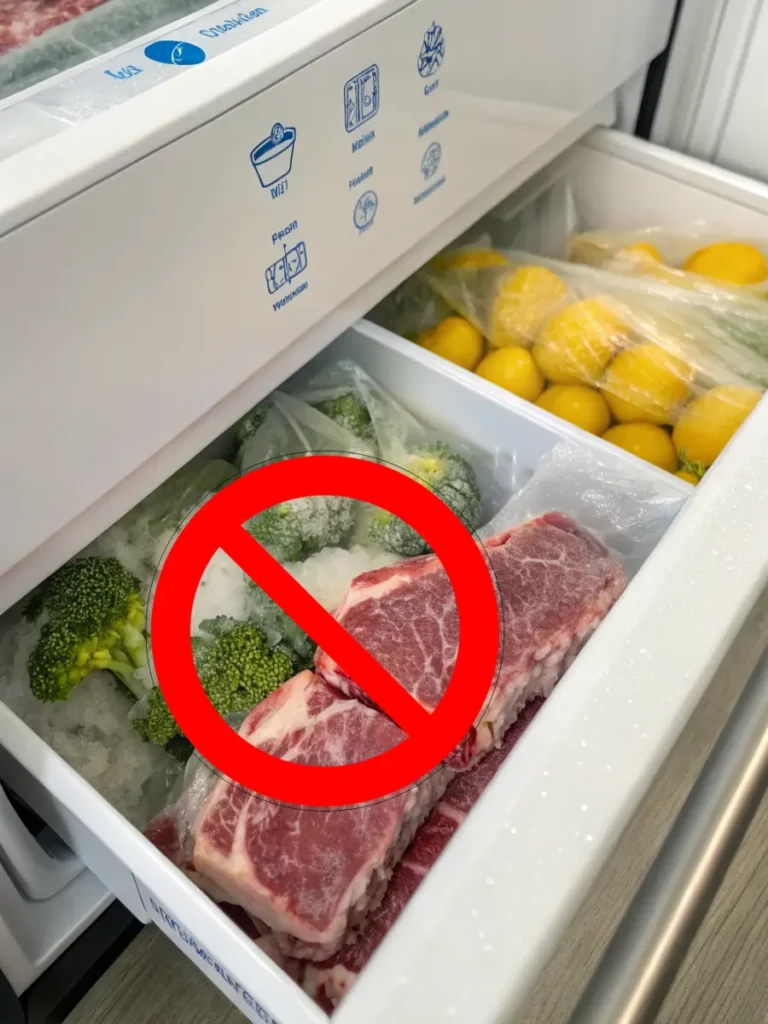
- Raw meat maintains optimal quality for 3-5 days when stored between 32-36°F (0-2°C)
- Store raw meat on the lowest refrigerator shelf to prevent cross-contamination
- Vacuum-sealed packages extend shelf life by up to 50%
- Cooked meat remains safe for 3-4 days when properly refrigerated
- Freeze uncooked meat wrapped in freezer paper, then plastic wrap, then foil for maximum protection
- Label all stored meat with type and date to maintain organization
Conclusion
This comprehensive guide to cooking with meat provides the fundamental techniques, timing precision, and professional insights needed to transform your meat preparation skills. By understanding quality selection, mastering cooking methods, and avoiding common pitfalls, you’ll achieve consistently excellent results that rival restaurant-quality meals. Start applying these proven techniques today to elevate your meat dishes from ordinary to extraordinary.
FAQs
How can I tell if meat is cooked to the right temperature without a thermometer?
While a thermometer is most accurate, you can use the touch test. Raw meat feels soft like the base of your thumb. Medium-rare feels like pressing the base of your thumb while touching your thumb and index finger together. Medium feels like thumb and middle finger together, and well-done feels firm like thumb and pinky together.
Why does my meat always turn out tough?
Toughness typically results from overcooking, cooking at too high a temperature, or not selecting the appropriate cooking method for the cut. Tougher cuts with more connective tissue require slow, moist cooking methods like braising.
Should I marinate all types of meat?
Not necessarily. Tender cuts like ribeye or filet mignon need only salt and pepper. Leaner or tougher cuts benefit most from marinades, which improve flavor and tenderness through acidic ingredients breaking down muscle fibers.
How long should I let meat rest after cooking?
A good rule is resting for approximately 5 minutes per inch of thickness or about one-third of the total cooking time. This allows juices to redistribute throughout the meat.
What’s the difference between grass-fed and grain-fed beef?
Grass-fed beef typically contains less total fat, more omega-3 fatty acids, and higher levels of certain vitamins. It has a distinct, sometimes described as “gamier” flavor profile compared to the milder, more marbled grain-fed beef that many consumers are accustomed to.
What is the perfect time to cook steak?
Determining the ideal cooking time for a steak hinges on a confluence of factors, primarily your desired doneness, the steak’s thickness, and the chosen cooking method. For those favoring a rare steak, a brief sear of 2-3 minutes per side is sufficient, while a well-done steak necessitates a longer cook time of 6-7 minutes per side. However, these are merely guidelines, as a thicker steak will inevitably require more time than a thinner one.
Grilling and pan-searing offer rapid cooking, whereas oven-baking and sous vide provide slower, more controlled results. Regardless of the method, the most accurate way to gauge doneness is with a meat thermometer, ensuring the internal temperature aligns with your preference: 125°F for rare, 130-135°F for medium-rare, and so forth. Allowing the steak to reach room temperature before cooking and letting it rest afterwards are also crucial steps for achieving a perfectly cooked steak.
There are no reviews yet. Be the first one to write one.

